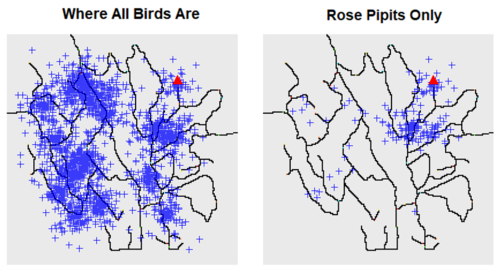ISSS608 2017-18 T3 Assign Chan En Ying Grace Did Rose Pipit kick the bucket
|
|
|
|
|
|
Contents
Cluster Visualisation: "Did Rose Pipit actually kicketh the bucket?"
1. Data Overview
Different bird species were found throughout the preserve, but Pipits were found typically in the northeastern side of the preserve – that is, closest to the alleged Dumping Site.
We can also see a Pipit cluster around the Dumping Site, where the dumping site is represented by the triangle below. This was likely why the alleged dumping by Kasios was “accused” to cause the death of the Pipits since the Pipits were found at that location.
2. Clustering by Species
To characterize the pattern relative to the alleged dumping site (blue triangle), the following facet plot shows the clustering patterns by Bird Species, independent of time.
From the cluster locations, we can see that the Rose-Crested Blue Pipits are clustered around the alleged dumping site, explaining why the 15 test birds provided are claimed to be Rose-Crested Blue Pipits to prove the allegation wrong. We can use this facet plot to have a good overview of other bird species’ cluster locations, such as the Ordinary Snape and Lesser Birchbeere being also clustered near to the Dumping Site.
3. Assignment of Treatment & Control Groups
If the dumping indeed took place, one would expect that other birds in this dumping area would also decrease in population as they would migrate elsewhere or die from the dumping substance, not just affecting the Rose Pipits.
Other species that are dominantly clustered around the dumping site include the Ordinary Snape and Lesser Birchbeere. These populations should also be affected by the dumping, if dumping indeed happened. We will thus use Ordinary Snape (OS) and Lesser Birchbeere (LB) as our Control Group, and Rose-Crested Blue Pipits (Rose Pipit) as our Treatment Group.


